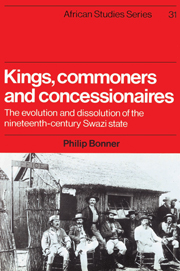 Kings, Commoners and Concessionaires
Kings, Commoners and Concessionaires Book contents
- Frontmatter
- Contents
- List of maps
- List of figures
- Preface
- Map 1 Modern Swaziland
- Map 2 Chiefdoms c. 1820
- 1 Introduction
- 2 The northern Nguni states 1700–1815
- 3 The conquest state 1820–1838
- 4 Factions and fissions: Mswati's early years
- 5 The balance tilts: Swazi–Boer relations 1852–1865
- 6 The deepening and widening of Dlamini power 1852–1865
- 7 Regency and retreat 1865–1874
- 8 Confederation, containment and conciliar rule: Mbandzeni's apprenticeship 1874–1881
- 9 The puff–adder stirs: Mbandzeni and the beginnings of concessions 1881–1886
- 10 The conquest by concessions 1886–1889
- 11 Conclusion
- Appendix
- Notes
- Bibliography
- Index
- KINGS, COMMONERS AND CONCESSIONAIRES
7 - Regency and retreat 1865–1874
Published online by Cambridge University Press: 22 September 2009
- Frontmatter
- Contents
- List of maps
- List of figures
- Preface
- Map 1 Modern Swaziland
- Map 2 Chiefdoms c. 1820
- 1 Introduction
- 2 The northern Nguni states 1700–1815
- 3 The conquest state 1820–1838
- 4 Factions and fissions: Mswati's early years
- 5 The balance tilts: Swazi–Boer relations 1852–1865
- 6 The deepening and widening of Dlamini power 1852–1865
- 7 Regency and retreat 1865–1874
- 8 Confederation, containment and conciliar rule: Mbandzeni's apprenticeship 1874–1881
- 9 The puff–adder stirs: Mbandzeni and the beginnings of concessions 1881–1886
- 10 The conquest by concessions 1886–1889
- 11 Conclusion
- Appendix
- Notes
- Bibliography
- Index
- KINGS, COMMONERS AND CONCESSIONAIRES
Summary
Mswati died at the beginning of August 1865, leaving behind a notably ambiguous legacy. On the one hand, an infrastructure of state had been firmly established, so that the country now divided more on class than on ethnic or chiefdom lines, and looked for the resolution of its grievances in the machinery of state. On the other, Mswati had died very young – he had yet to reach forty at the time of his death – and left behind no acknowledged heir. Successive efforts to obtain a main wife from Mzilikazi and Mpande had miscarried, and before new approaches were under way Mswati was dead. The resulting struggle provides an interesting commentary on the new-found maturity of the Swazi state, both in so far as all parties were competing to control rather than dismember society, and in the way in which the defeated party reconciled itself to its position once the die was cast. This chapter will examine the implications of that struggle and the regency that followed, together with their repercussions on Swaziland's regional position.
A leading contender for the kingship was Mbilini, the son of laMakhasiso, Mswati's chief wife at Hhohho. Constitutionally Mbilini was debarred from taking office, because his mother was Mswati's first wife, but there are signs that Mswati had considered him as a possible successor. Mbilini certainly thought so, and claimed that Mswati had announced precisely that as he lay dying in the arms of his brother Maloyi. Mbilini's claim must obviously be treated as a piece of special pleading, but it would be equally unwise to ignore the reasons that must have existed to push Mswati in this direction.
- Type
- Chapter
- Information
- Kings, Commoners and ConcessionairesThe Evolution and Dissolution of the Nineteenth-Century Swazi State, pp. 103 - 125Publisher: Cambridge University PressPrint publication year: 1983
